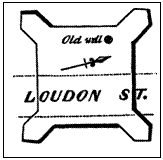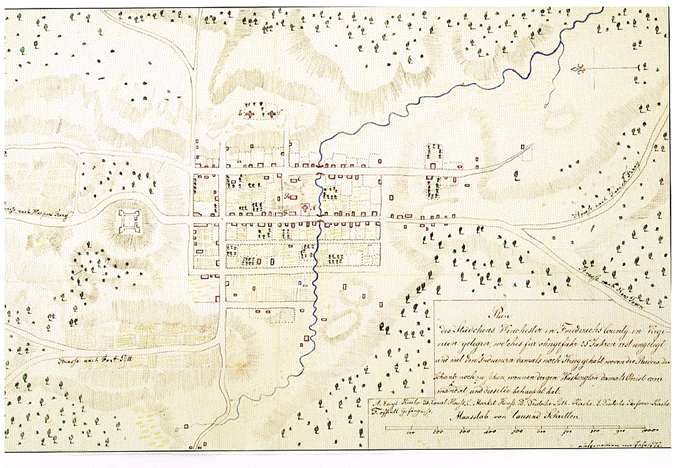A History of Fort Loudoun
The fort which gives the Fort Loudoun Chapter, NSDAR its name was built after the defeat of General Braddock at the dawn of the French and Indian War. At this time, most of the frontier was protected not by forts but by small stockades, fortified houses, and blockades. Several months after being posted in Winchester, it was the then-Colonel George Washington who was in charge of overseeing the construction of a fort.
The fort, which was named in honor of John Campbell, the fourth Earl of Loudoun, began construction in May of 1756. It was constructed on top of a hill that later came to be known as "Fort Hill." It was said that George Washington brought his own blacksmith from Mount Vernon in to forge the necessary iron work for the fort. The fort that was built was on the smaller side: enclosing one-half acre with the length of each curtain at ninety six feet and the bastion face and flanks at twenty five feet long. Part of the hill had to be built up in order to erect one of these bastions. This built up portion of the hill can still be seen today.
Fort Loudoun also possessed armaments of six 18-pounders, six 12-pounders, six 6-pounders, four swivel guns, and two howitzers. The water for the fort came from a well that had been blasted through the rock to a depth of 103 feet. Other than the built-up part of the hill that supported a bastion, only the well can still be seen today.
Unlike most forts of the day which were constructed of a single row of logs (Fort Cumberland used single logs 18 feet in length which were then sunk into the ground at a depth of 6 feet), Fort Loudoun had a "double defense." Parallel rows of upright logs two feet apart from one another that were then filled with dirt constituted the walls of Fort Loudoun—a strong and formidable defense. 
The construction of the fort took over two years, a fact that frustrated George Washington. Even though it wasn’t completed, it still had a rough functioning as a fort. After its completion, the fort saw no major battles and only a few skirmishes. It was said that French officers reconnoitered the fort and found it to be impregnable.
After the French and Indian War, there was little use for the fort. In 1777, a captured Hessian officer wrote that he could still see the remains of the fort that George Washington himself had commanded. By the Civil War, very little of the fort remained. Only one bastion of the fort and the well was left. Much of the it was dismantled when Loudoun Street was extended, which cut right through the fort. Local history states that much of the wood and stone that went into the fort was dismantled and used in the construction of houses for Winchester.

Bibliography
Powell, Allan. Fort Loudoun: Winchester's Defense in the French and Indian War. Parsons: McClain Printing Company, 1990.
Quarles, Garland R. George Washington and Winchester, Virginia 1748-1758. Winchester: Winchester-Frederick County Historical Society, 1974.
Winchester-Frederick Co Historical Soc Collection. "Map - Winchester, VA (1777)." Accession number: 69-158 wfchs John Handley Library, n.d.